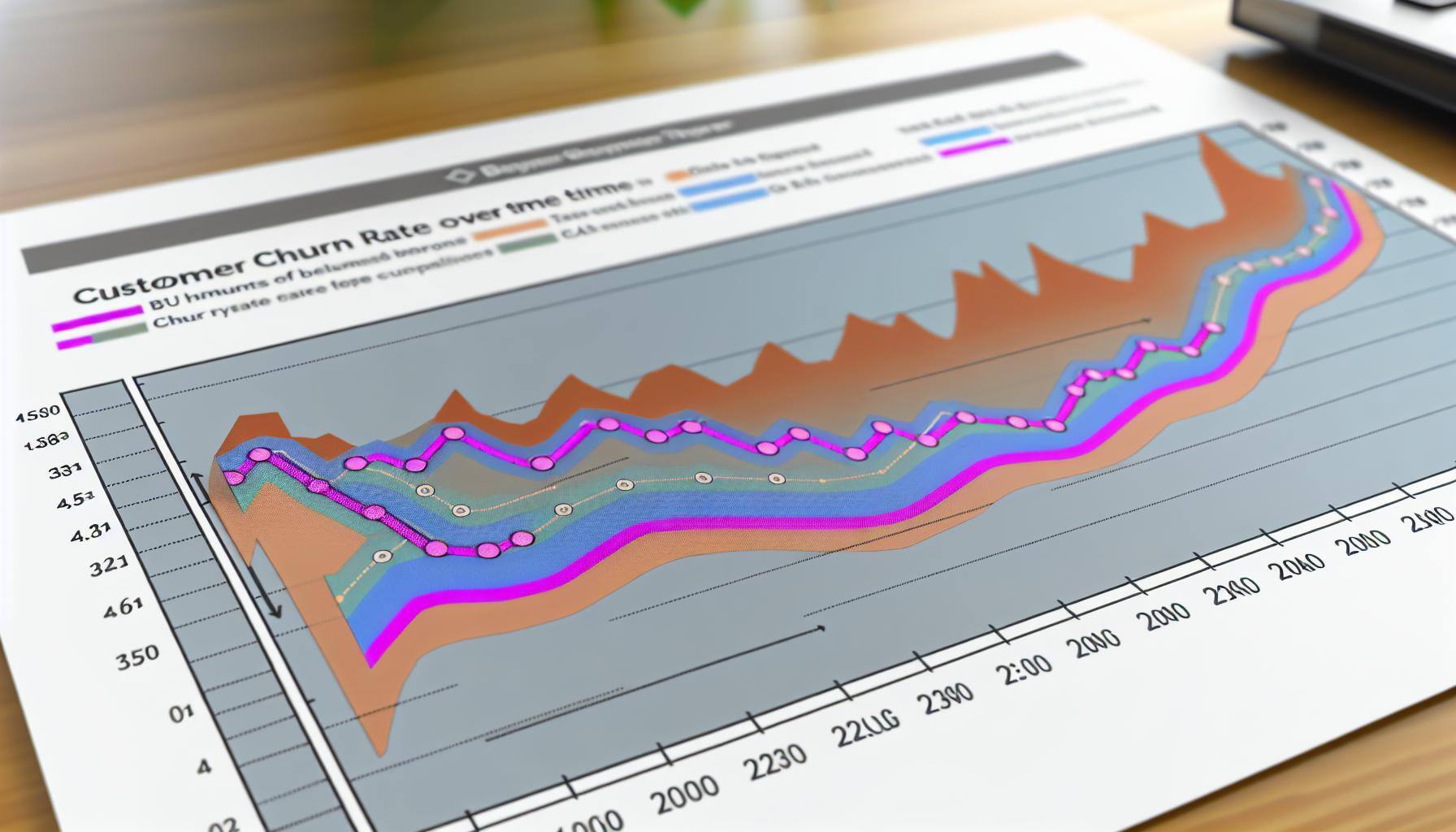Effective Ways to Reduce Customer Churn in B2B SaaS Companies
Customer churn represents a critical challenge for B2B SaaS companies. Churn occurs when customers stop using a product or service, leading to lost...
5 min read
Brian Polackoff
:
Oct 28, 2024 11:11:00 AM

In today's competitive business landscape, understanding customer churn and developing strategies to reduce it are paramount to sustaining growth and profitability. Customer churn refers to the phenomenon where customers stop using a company's products or services. Managing churn effectively can significantly contribute to customer retention and overall business success. This article delves into the intricacies of customer churn, methods to calculate churn rate, and strategies to reduce customer churn, all while enhancing the customer's journey and satisfaction.
Customer churn, often referred to as customer attrition, is a critical metric in understanding how many customers a business loses over a specific period. This metric can be particularly telling about issues within the customer experience and satisfaction. There are different types of churn, including voluntary churn, where a customer leaves by choice, and involuntary churn, often caused by factors outside the customer's control, such as payment failures. Understanding the definition of churn is the first step in addressing and preventing it.
The impact of customer churn extends beyond the loss of revenue. A high churn rate can also indicate deep-rooted issues within the business model, such as poor product or service quality or inadequate customer support. It often leads to increased customer acquisition costs as more resources are invested in attracting new customers to replace those who have left. Furthermore, businesses with high churn rates might struggle to achieve a stable customer base, leading to fluctuating cash flows and diminished customer lifetime value.
Customer churn is a vital metric that directly influences a company's profitability and long-term success. A high churn rate can signal that customer needs are not being met or that the customer experience is lacking, prompting the need for immediate attention. By focusing on reducing churn, businesses can improve customer retention, leading to enhanced customer success and satisfaction. Addressing churn effectively can transform customer feedback into actionable insights, which helps tailor products or services to better suit the target audience.
Calculating the churn rate accurately is essential for understanding the health of a business. To calculate churn rate, first determine the number of customers lost during a specific time frame. Then, divide this number by the total customer count at the start of the period. This calculation yields the churn rate, which is usually expressed as a percentage. It reflects how well a company retains its customers over time, highlighting areas for improvement in customer acquisition and retention strategies.
To illustrate, if a company began the month with 1000 customers and lost 50 by the end of the month, the monthly churn rate would be calculated as 50 divided by 1000, resulting in a 5% churn rate. This calculation is crucial for businesses aiming to monitor trends over time and adjust strategies accordingly. Whether the churn is a result of dissatisfaction with a product or service or a broader market trend, understanding the churn rate aids in making informed decisions to prevent further attrition.
Several advanced tools and software are available to track churn and conduct detailed analyses. These tools help businesses identify patterns and potential risk factors contributing to customer churn. By leveraging data analytics, companies can develop sophisticated churn models that predict future churn trends. This enables proactive measures to improve customer satisfaction and retention, ultimately aiding in reducing customer churn over the long term.
Understanding the common causes of customer churn is essential in crafting effective churn reduction strategies. Poor customer experience, inadequate customer support, subpar product or service quality, and misalignment with customer needs are frequent culprits. Additionally, high competition and better offers from competitors can lure customers away. Identifying these causes helps businesses address weaknesses and enhance their value propositions to retain their customer base.
The quality of a product or service plays a significant role in customer retention. A good customer experience hinges on consistently meeting or exceeding customer expectations. When a product or service fails to deliver promised benefits, customer dissatisfaction ensues, significantly increasing the risk of churn. Therefore, maintaining high standards and continuous improvement in product or service offerings are crucial in mitigating customer attrition.
Customer experience encompasses every interaction a customer has with a business throughout the customer journey. A positive experience can foster loyalty and advocacy, while poor experiences often lead to churn. Companies that invest in understanding and improving customer experience tend to reduce churn by aligning their offerings with customer needs, enhancing engagement, and providing stellar customer support. Personalized experiences and active listening through customer feedback further solidify a company's relationship with its customers.
Preventing churn requires a strategic approach, focusing on both reactive and proactive measures. Reactive measures include addressing immediate customer concerns and complaints through effective customer support. Proactive strategies, such as implementing loyalty programs, offering personalized deals, and continuously enhancing the product or service, can help prevent churn before it occurs. Businesses should also foster open communication channels, encouraging customers to share feedback and suggestions.
Improving the customer experience is one of the most effective ways to reduce churn. This involves creating seamless and enjoyable customer journeys, ensuring that all touchpoints with the brand are positive. Companies can achieve this by training customer-facing employees to provide exceptional service, implementing user-friendly technologies, and ensuring swift and satisfactory resolutions to customer issues. Continuous engagement with customers and understanding their evolving needs is vital in cultivating satisfaction and loyalty.
Successful customer retention tactics include loyalty programs, personalized communication, and exclusive member benefits. These tactics not only incentivize continued usage but also enhance the emotional connection between the customer and the brand. Additionally, reducing the customer acquisition cost by focusing on retention can maximize revenue potential from existing customers. By analyzing customer success metrics and adjusting strategies accordingly, businesses can effectively lower their churn rate.
Tracking customer churn is critical for understanding the dynamics of a business's customer base. By systematically tracking churn rates, companies can identify trends and potential issues early, enabling them to react swiftly. Regularly monitoring churn also aids in assessing the effectiveness of customer acquisition and retention strategies. Analyzing churn data provides insight into customer behavior, preferences, and satisfaction levels.
Churn analysis is a powerful tool in decision-making processes. By dissecting the reasons behind customer attrition, businesses can make informed decisions that align with customer needs and market demands. This analysis often involves segmenting the customer base, examining different types of churn, and understanding demographic and behavioral patterns. The insights gained from churn analysis empower businesses to refine their offerings and enhance their competitive edge.
Implementing effective churn reduction strategies requires a comprehensive approach that encompasses all aspects of customer interaction. From improving customer support to innovating product features, every element must aim to increase customer satisfaction and retention. Encouraging positive customer feedback and acting on negative churn indicators are essential components of a successful churn reduction strategy. Additionally, leveraging customer success stories and testimonials can fortify trust and engagement, ensuring long-term customer loyalty.
Churn Assassin is designed to empower B2B SaaS companies with the tools they need to proactively reduce churn and increase customer retention. By leveraging predictive analytics and behavioral tracking, the platform identifies early signs of disengagement, allowing your customer success team to take action before clients cancel. With features like customer health scoring, cohort analysis, and custom alerts, Churn Assassin ensures that your team focuses on high-risk accounts and prevents churn at every stage of the customer journey.
In a highly competitive SaaS landscape, losing customers can have a significant impact on revenue and growth. Churn Assassin helps you stay ahead by providing data-driven insights, personalized engagement strategies, and a clear roadmap to retaining more clients. Don’t let churn hurt your bottom line—sign up for a free demo of Churn Assassin today and start boosting your retention rates and growing your business!

Customer churn represents a critical challenge for B2B SaaS companies. Churn occurs when customers stop using a product or service, leading to lost...

In the rapidly evolving landscape of SaaS businesses, understanding and mastering customer churn is imperative for maintaining long-term success....

For your Software as a Service (SaaS) company, churn—the rate at which customers discontinue their subscriptions—is a critical health metric. Since...